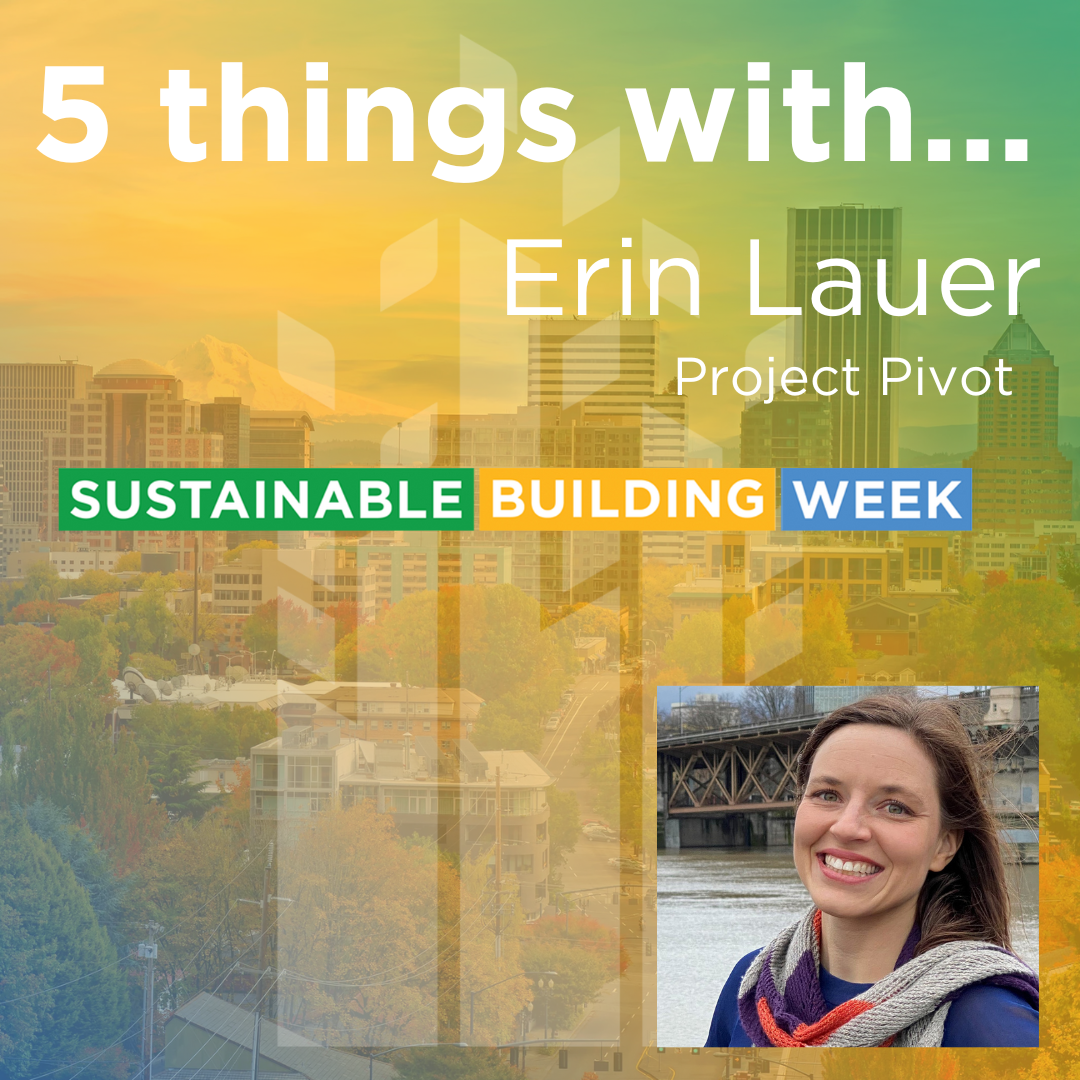Five Things … with Erin Lauer, Project Pivot

Five Things … with Erin Lauer, Project Pivot
We’re celebrating five years of Sustainable Building Week and to help mark the occasion we’re launching Five Things: a series of interviews that connects our five years to you, Portland’s sustainability community. In the coming weeks, follow along as we share answers to five questions we’re posing to some of the biggest movers and shakers in our city, who are working to keep Portland green.
Describe your day job.
I am part-owner of Project Pivot, a women-owned sustainable building consulting firm in Portland. At Project Pivot, we help clients to realize their project’s and team’s sustainable building goals and to provide healthier habitats for both occupants and our surrounding environment, all within the project team’s budget.
This overlaps with my volunteer work with the AIA Oregon Committee on the Environment (COTE) where I get the opportunity to collaborate with a diverse group of designers and other professionals across the state, who all wish to share our stories and resources regarding sustainable design in our state.
We also collaborate with different COTE groups across the country, this portion largely led by our AIAO COTE Co-Chair Elisa Rocha. Together and with our communication with the AIA Oregon, we all share our knowledge by leading building tours, providing access to sustainable design tools, such as energy modeling, daylight analysis, and life cycle analysis to name a few, and finally through amazing AIA health safety and welfare (HSW) educational presentations that often highlight a project within our region that raises the standard for environmentally friendly and equitable design.
It is exciting to collaborate with designers, engineers, urban planners, utility providers, and state and local policymakers about all of the exciting work in our region.
What have you learned from previous sessions at Sustainable Building Week?
There have been amazing collaborations with regional and City of Portland officials, working with local planners and architects. I’ve learned everything from improving my own lifestyle and home to enhancing conversations with clients, owners, and architects, on how to integrate the best possible sustainable designs within their projects.
What does “sustainable” mean to you?
Providing healthy environments, indoor and outdoor, and substantial resources, for all who inhabit our planet and communities, for current and future generations.
What inroads has Portland made and what still needs to be done to “keep Portland green?”
Portland’s Clean Energy Fund has really helped projects in underserved neighborhoods to meet their goals. We still have a housing crisis in Portland, but the City of Portland and developers in the area are doing their best to integrate sustainability with the safety and health of the building occupants as the focus. By opening up opportunities to receive affordable housing funding, beyond the three allowable sustainable certifications, more affordable housing projects may be able to be constructed more quickly. Working within our constraints, and providing healthy housing for all is imperative.
Name a Portland (or Oregon) project or collaboration that has inspired you and tell us why you are inspired by it.
I’m inspired by Project Pivot’s work and collaboration with the amazing design team for the major building renovation and design of the Portland State University Vernier Science Center, with Bora Architects. Bora pulled together a diverse team of high-performing professionals, all of who hold a deep and invested interest and commitment to sustainability, including each of the design consultants and the owner PSU. Our communication has been clear, and we all seem to have the same goals for the building, all being done within a very tight budget. The design incorporates reusing more than 90% of the existing building structure, reducing the project’s carbon impact from the offset. These renovation projects in an urban core are not easy, and this team is realizing its potential.
Another amazing project was the Meyer Memorial Trust headquarters, where LEVER Architects collaborated with Sustainable Northwest Wood to carefully plan regional wood choices that also benefit the local economy, environment, and diversity. I learned more about this project through an AIA Oregon Committee on the Environment (COTE) Digital Design Series presentation. Chandra Robinson will also speak about this at the upcoming AIAO COTE Green Champion Summit, part of Sustainable Building Week, on Monday, October 10.
Recent News
September 19, 2023
September 15, 2023
August 16, 2023
Stay in the Know!
© 2024 Sustainable Building Week. Website by Triple Play Studio


